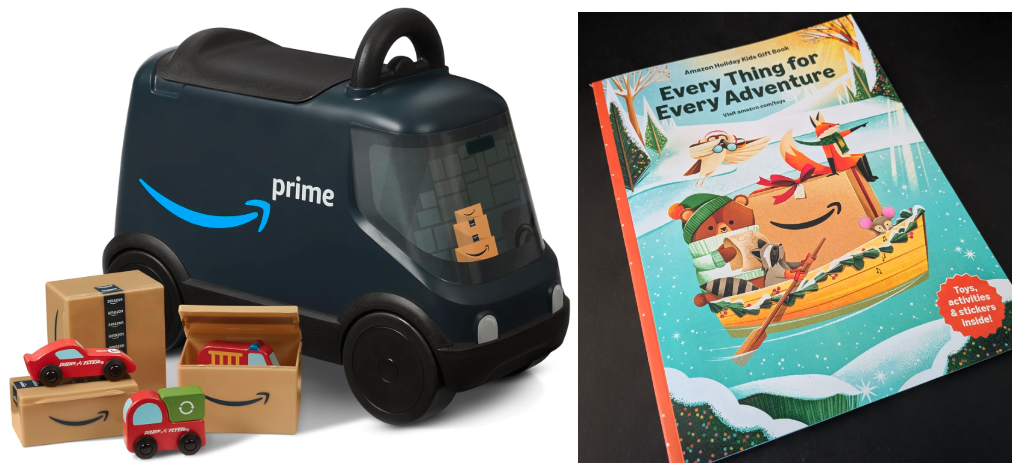Amazon’s Toy Delivery Van Sparks Imagination and Raises Eyebrows
In a delightful yet thought-provoking marketing move, Amazon has introduced a children’s ride-on toy delivery van in its new 92-page holiday gift catalog. The bright blue scooter-style toy, adorned with the familiar Prime logo, is designed for children as young as two years old. Complete with a seat on top and a steering handle, this miniature version of the ubiquitous delivery vehicles now circulating neighborhoods nationwide allows toddlers to mimic the delivery process that has become such a familiar part of modern American life. The toy comes with three small Amazon boxes, each containing wooden toy vehicles, cleverly introducing children to both the joy of receiving packages and the role of delivery personnel in our increasingly e-commerce-driven society.
The toy delivery van, manufactured by the venerable Radio Flyer company known for generations of classic red wagons, retails for $46 on Amazon’s website. Customer reviews have been overwhelmingly positive, with an impressive 4.8 out of 5 stars average rating. Parents frequently comment about their children’s excitement while role-playing as delivery drivers, suggesting that the toy successfully taps into children’s natural desire to mimic adult activities they observe. The cargo area tucked under the seat allows little ones to load up their pretend deliveries – whether it’s the included toy boxes, books (a nod to Amazon’s origins as an online bookstore), or perhaps toy versions of everyday household items like batteries and toilet paper that have become Amazon staples.
What makes this toy particularly interesting is how it normalizes Amazon’s massive delivery infrastructure for the youngest generation. While perfectly innocent as a toy, it raises subtle questions about brand awareness and career aspirations being shaped from toddlerhood. Are these little delivery drivers-in-training being “primed” (pun intended) to view Amazon as an integral, natural part of daily life rather than a relatively recent development in consumer culture? The toy transforms what is essentially corporate logistics into child’s play, blurring the lines between entertainment, brand familiarity, and early occupational role-playing. Children who might once have pretended to be firefighters, doctors, or teachers can now add “Amazon delivery driver” to their imaginative repertoire.
From a practical standpoint, the foot-powered nature of the toy aligns nicely with Amazon’s stated environmental goals. As the company works toward achieving net-zero carbon emissions across its global operations by 2040, the human-powered toy van presents a sustainability message that’s age-appropriate and parent-friendly. No batteries required, no emissions produced – just good old-fashioned kid power propelling these miniature Prime vans around living rooms and sidewalks nationwide. This environmentally conscious aspect provides a positive counterbalance to criticisms Amazon has faced regarding packaging waste and the carbon footprint of its massive delivery operations.
The toy also inadvertently highlights the sanitized, idealized version of delivery work presented to children versus the more complex realities faced by actual Amazon drivers. While little ones happily scoot around delivering pretend packages, they’re blissfully unaware of the controversies that have surrounded Amazon’s treatment of its delivery workforce – including disputes over working conditions and the infamous allegations about drivers using bottles for bathroom breaks due to intense delivery schedules. As one wry observer noted, the toddlers using this toy are likely still in diapers, making such controversial accessories unnecessary for these pint-sized delivery personnel. This stark contrast between the cheerful toy version and the sometimes challenging reality of delivery work creates an interesting juxtaposition.
Ultimately, the Amazon toy delivery van represents the continuing evolution of how corporate brands integrate themselves into childhood experiences. From McDonald’s Happy Meal toys to LEGO sets featuring recognizable store chains, children have long been exposed to branded play experiences. This particular example is noteworthy for how it transforms a service-sector job into an aspirational play pattern, all while building brand loyalty from an extremely young age. Whether viewed as a clever marketing strategy, a reflection of Amazon’s cultural significance, or simply a fun toy that happens to feature a familiar logo, the miniature Prime van certainly provides food for thought about how children’s toys both reflect and shape our economic landscape. As two-year-olds happily deliver packages around their living rooms, they’re participating in a complex interplay of commerce, imagination, and perhaps even career preparation – all before they’ve learned to read the boxes they’re so enthusiastically delivering.














